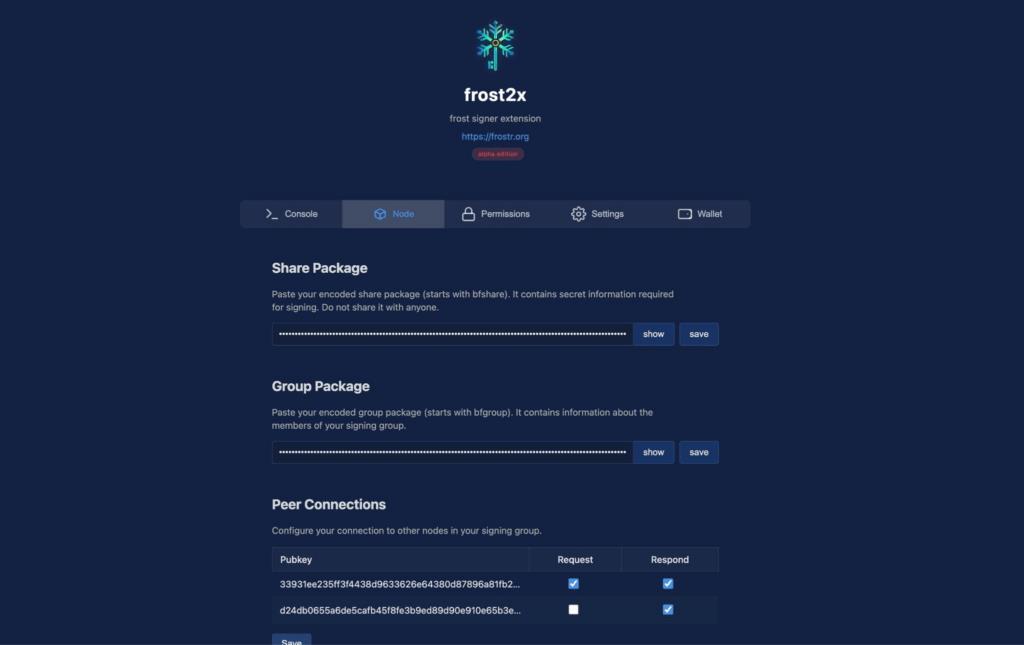
Secure Your Nostr Identity: How Frostr Eliminates The Need For Password Resets

No Password Reset? Discover How Frostr Secures Your Nostr Identity
Initially conceived during a hackathon at TABCONF 2024, Frostr has pin-pointed a challenging issue concerning Nostr : the inability to reset your password if your private key is compromised.
Launched in October 2024, Frostr unveiled the alpha version of Igloo and Frostr2x , which function as desktop applications and browser extensions designed for key signing within the Nostr ecosystem.

The brainchild of Topher (cmdruid ), a noteworthy Bitcoin engineer recognized for creating Tapscript -a widely-used tool for handling Taproot, Schnorr signatures, and assorted Bitcoin transactions-along with Austin (bitcoinplebdev ), a Lightning developer at Voltage and the founder of PlebDevs , a platform focused on educating developers using Lightning, boasting over 500 enrolled students.
While the action of resetting a password might seem trivial or merely a basic user interface feature, the reality is more complex. I invite you to explore the intricate challenges and the serious implications of failing to tackle this seemingly straightforward issue.
The Transformation of Social MediaSocial media has radically transformed our society. Yet, we now find ourselves in a peculiar situation regarding our online identities. The way we project our identity and assert ownership of our online profiles often hinges on monopolistic entities like Facebook, which can alter the rules arbitrarily or altogether suspend your account.
The removal of contentious figures, including politicians, from major platforms in recent years highlights how this centralized authority can be exploited. A prominent example is the banning of former U.S. President Donald Trump from both Facebook and Twitter following the incidents of January 6 at the Capitol, just days before he completed his first term.
Despite this, the global digital landscape continues to function within a neo-feudal framework. It seems we are facing an unresolved dilemma concerning the“decentralization” of identity.
Modern-Day Identity CrisisIdentity systems constitute a vital layer of societal structure. From ancient Rome to present-day America, access to opportunities often hinges on the identification documents one possesses. Although today's identity verification systems may appear advanced, they ultimately draw from a pre-digital understanding of identity and security, relying on methods such as facial recognition.
ID cards, whether they be driver's licenses or passports, enable government officials, bankers, and even nightclub bouncers to accomplish a fundamental task: confirming your likeness against the official identification and determining if you are granted access.
However, the world is shifting rapidly. The veils of anonymity surrounding physical characteristics and the confidentiality of social security numbers (SSNs) have been compromised in the internet age. Countless individuals have their full names and photographs available on social media, while massive data breaches have exposed enormous quantities of SSN information on the dark web. For instance, the Equifax Data Breach in 2017 affected nearly 148 million Americans, while the National Public Data Breach of 2024 compromised the data of over 200 million individuals.
In a bygone era, if a heist occurred at a local bank, thieves were typically after cash, gold, and valuable assets stored in vaults.
In today's digital landscape, however, the concept of“money” has vastly changed. Traditional fiat payments can be reversed, rendering any illicit banking transaction traceable and linked to someone's identity.
In this digital context, the modern-day“robber” is not after physical cash or valuables, but rather, personal identity data.
This sensitive information can then be exploited for fraudulent schemes against financial institutions and other businesses, irrespective of their size.
In fact, identity theft incurs costs exceeding all other forms of theft combined, accounting for over $56 billion in 2020 alone.
Moreover, several centralized platforms have fallen victim to security breaches, resulting in their data being sold on the dark web at a pittance. With the rapid advancement of AI technologies, rogue actors can now create convincing fake selfies paired with imitation IDs using compromised user data, potentially tricking the custodians of your digital assets.
This imminent threat has spurred changes in identity management systems, exemplified by California's mobile driver's license application, mDL . Developed in collaboration with Google and Apple, this app aims to simplify identity verification at airports, and even encourages developers to incorporate it into various website authentication mechanisms. Similarly, ID has embraced this model, fully integrating with the IRS and amassing over 136 million users.
Many of these applications necessitate face or fingerprint recognition, demanding increasingly convoluted KYC selfies where users must present ID cards alongside recent newspapers to validate their identity.
Despite the evident vulnerabilities of biometric identification in an era dominated by social media, technology powerhouses continue to lean heavily on biometric data, frequently intertwining it with extensive surveillance systems akin to those seen in China's social credit initiatives being developed . in Mainland China .
To mitigate what seems to be an inevitable fate as this trend encroaches on the West, we need an identity management system that is secure and does not rely on biometric information. A viable solution must transcend facial recognition and its associated risks.
Introducing Nostr: A Protocol for Identity and Social Media in the Bitcoin EraEmerging from the Bitcoin developer community, Nostr has swiftly established itself as a unique social media network.
This protocol's cumbersome full name,“Notes and Other Stuff Transmitted by Relays,” signifies its empowering capability, allowing users to authenticate through pseudonyms (nyms) on social media and digitally sign their content with a Bitcoin -style private key. By providing self-custodial features, Nostr fundamentally democratizes the current internet structure, paving the way for an array of possibilities in social networking.
Advocates assert that Nostr enables users to genuinely own their data and liberates them from the caprice of Silicon Valley behemoths, irrespective of platform changes or political biases.
Operating on a decentralized client-server network design, Nostr facilitates content access across various servers, or relays. If one relay experiences downtime or engages in unwarranted censorship, users can typically find alternative access points to the Nostr content stream, enabling them to share their perspectives freely.
Nostr aspires to unveil a groundbreaking generation of social media that avoids transforming users into mere products by harvesting their data. It strives to shun mandatory biometric verification, safeguards privacy, and allows developers to innovate within a transparent network supported by open-source cryptography and seamlessly linked to Bitcoin -referred to as the internet's currency.
For celebrities and users aiming to protect their Nostr personas from impersonators, a model similar to that constructed by Keybase offers a potential remedy. Keybase encourages users to publicize and validate their identities using DIDs with their other social media accounts, thereby consolidating reputation indicators into a cryptographically secure identity. Although this procedure has not yet gained traction within Nostr, it represents a complication that Keybase has addressed effectively through decentralization.
Nonetheless, the landscape is not without its hurdles. Empowering users with ownership of their identities introduces additional challenges that have deterred many, myself included, from fully embracing the Nostr platform for brand development.
Limitations of Password ResetsCurrently, there lacks a genuine mechanism to reset a Nostr nym or identity. Operating on a straightforward public-key system, any compromise of your private key results in your identity being usurped by the perpetrator since both parties possess the secret (there is no unique control over it).
This presents a monumental issue. While such hacks are relatively infrequent, the potential risk creates a significant barrier for brands contemplating substantial investments in this emerging social network protocol.
The risk is exacerbated by Nostr's design, which encourages the creation of diverse interfaces to access various types of content, leading users to share their private keys with multiple clients and amplifying the chances of unauthorized access.
An external signer, often manifested as a browser extension like Alby , has emerged as a popular solution to manage private keys in a manner akin to a password manager, facilitating signing actions across various Nostr platforms. However, while this approach is somewhat effective, it fails to resolve the core issue. A single misstep can lead to the compromise of the nym, not just damaging the reputation but also exposing it to exploitation by scammers impersonating you to harass friends or clients.
Such impersonation issues echo those prevalent across Facebook, Instagram, and Twitter, where rogue entities clone profiles and deceive acquaintances through phishing schemes; however, the stakes are even higher in Nostr because an attack could compromise your actual identity, not a mere fake profile, significantly undermining trust in the integrity of all posts for those aware of the risks.
The apparent solution seems straightforward: simply implement a password reset feature. Right?
That assumption is misleading, as executing password resets necessitates relinquishing identity control to a third party, which can amend a centralized database and issue you a new key set.
Until now, that has been the situation. Let's explore how Frostr alters this narrative.
Introducing Frostr: A Leap Forward in Key ManagementRecent advancements in cryptography are reshaping self-custody within the Bitcoin and cryptocurrency arenas. One rapid innovation gaining traction is Frostr, a Schnorr-based key management and rotation system that mirrors the functionality of Bitcoin multi-signature addresses and transactions, but without the on-chain costs or privacy drawbacks.
Schnorr, a form of cryptography introduced in the 1990s, gained attention as a prospective upgrade for Bitcoin following the expiration of its patents. It was ultimately integrated during the Taproot soft fork in 2020.
During the same year, Chelsea Komlo and Ian Goldberg released“FROST: Flexible Round-Optimized Schnorr Threshold Signatures,” a technical specification establishing its application within Lightning Network infrastructure and new multi-signature self-custody frameworks dubbed FROST.
Delving into the complexities of its cryptography extends beyond this article's scope, but it bears resemblance to concepts like Shamir's secret sharing. The involved cryptographic principles allow users to create a 24-word seed with Trezor 's hardware wallet, which can be divided into three shares, each containing 12 words. Any combination of two shares can reconstruct the master private key, whereas a singular share remains ineffective for compromising or recovering access to the account.
For a succinct introduction to FROST, watch this two-minute video by Andrew Poelstra, Blockstream's Head of Research:
This same framework is utilized in FROST, designed to enable multi-party, multi-signature wallets similar to those operated by exchanges, providing individuals with enhanced privacy and reduced transaction costs.
Frostr builds upon FROST by integrating it with Nostr's relay protocol-hence the addition of“r” in the name. It also tailors the technology for single-user wallets, rather than the high-grade, multi-user structures typical of exchanges, simplifying installations and enabling key rotation (password resets) for individual users employing single key pairs typical to Nostr.
Frostr introduces three key features:
- Threshold key signing to ensure that if one key is compromised, it can be replaced with a fresh set of sub-keys that generate the Nostr private key pair, without necessitating changes to your Nostr public and private keys (nsec). This operates similarly to a 2-of-3 multisignature Bitcoin wallet, where if one key is compromised, the remaining keys can facilitate moving funds to a new secure structure, regaining control over three new keys off-chain. It is undeniably revolutionary.
- No requirement for application-level solutions for Nostr key rotation; only the key signers like Alby must adapt to incorporate Frostr, allowing Nostr applications such as Primal or Damus to operate unaware that Frostr is being utilized for user key rotation.
- For users already holding Nostr accounts, whose nsecs remain intact, there is no need to switch to new key pairs and identities; instead, they can simply detach their nsecs from the current key signers and transition to Frostr for a more secure key management regime.
The end result? A crucial piece of the decentralized social media puzzle is unveiled: Trustless identities with password resets that does not rely on centralized authorities for authentication.
If successful, the implications of this innovation are profound. The Nostr ecosystem should carefully consider Frostr; it might just pave the way for an entirely new era of non-biometric, trustless digital identities and sovereign data ownership tailored for the Bitcoin generation.
For a deeper exploration of Frostr, visit their website at Frostr or check out this podcast I recorded with Topher and Austin discussing the topic.
#8211;The-Juan-Galt-Show-e30op20
This article No Password Reset? Discover How Frostr Secures Your Nostr Identity first appeared in Bitcoin Magazine , authored by Juan Galt .
Crypto Investing Risk WarningCrypto assets are highly volatile. Your capital is at risk.
Don't invest unless you're prepared to lose all the money you invest.
This is a high-risk investment, and you should not expect to be protected if something goes wrong.
Legal Disclaimer:
MENAFN provides the information “as is” without warranty of any kind. We do not accept any responsibility or liability for the accuracy, content, images, videos, licenses, completeness, legality, or reliability of the information contained in this article. If you have any complaints or copyright issues related to this article, kindly contact the provider above.






















Comments
No comment